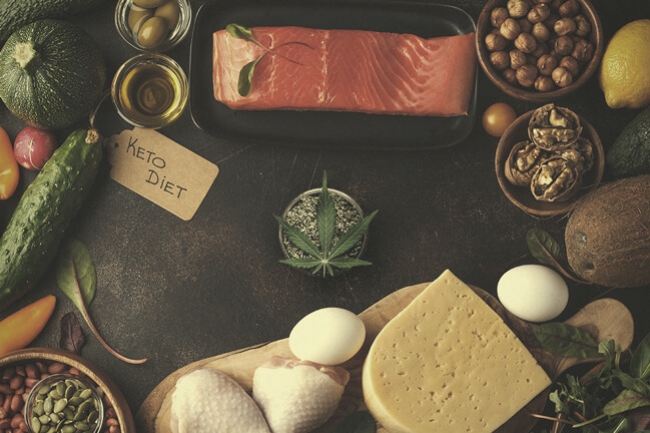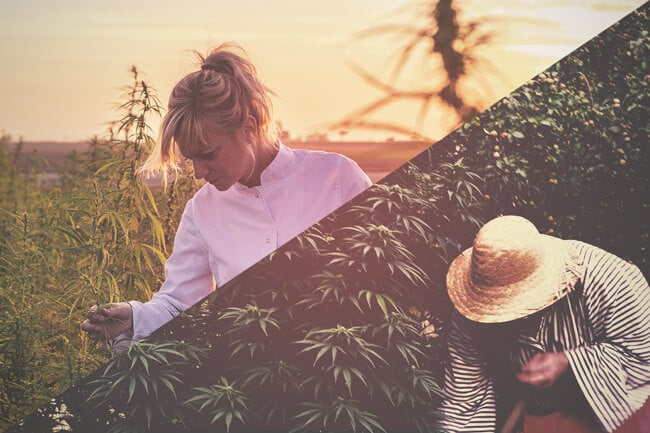.
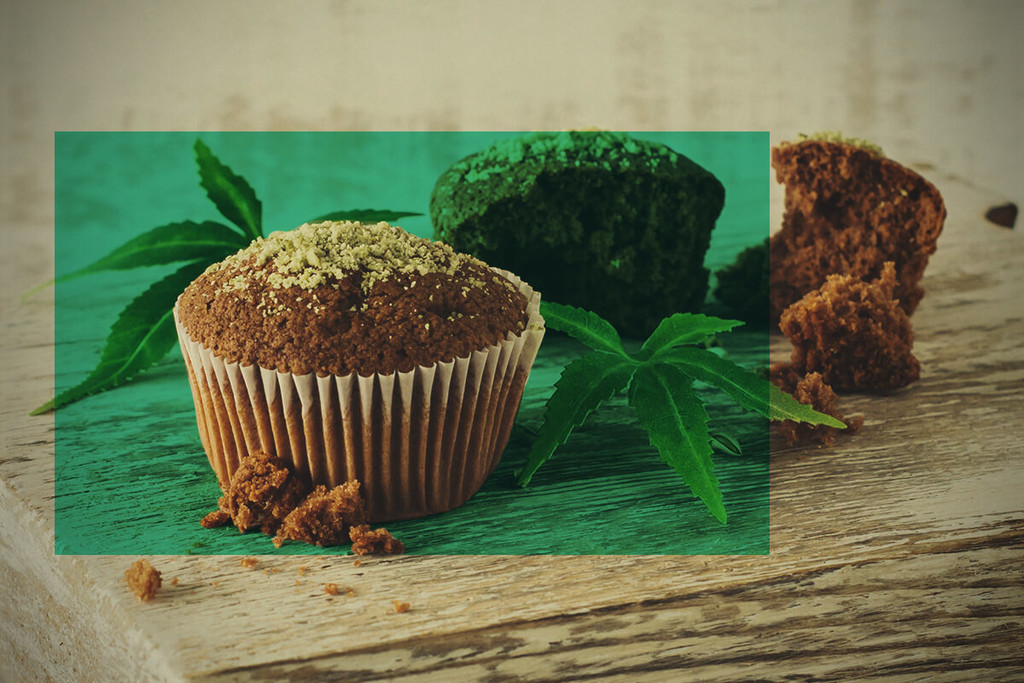
How To Cook With CBD at Home
Cannabidiol is an amazing cannabinoid with a ton of benefits, and adding CBD to your favourite recipes is one of the best ways to enjoy its versatile influence. Read on to learn more about cooking with CBD.
Contents:
Over the last couple of years, CBD has grown into a billion-dollar industry. And for good reason; this non-intoxicating cannabis-derived compound may have some potential as a wellness supplement.
If you’re interested in taking advantage of its posible benefits, you may be considering including CBD in your cooking.
Cooking With CBD: How Does It Work?
CBD, like many other cannabis compounds, is fat-soluble. And since we almost always use some kind of fat in our cooking, infusing your favourite recipes with CBD is super simple. Infuse your favourite aromatic cooking oils or fats, such as olive oil or ghee, with CBD and use them to spice up your favourite savory dishes (like sauces, stews, and dressings), or use more neutral fats such as coconut oil to work it into your favourite sweet treats.
Here are a few tips to help you start cooking with CBD.
Cooking With CBD Oil
Many of the CBD oils on the market are made by diluting CBD extract (derived from CBD-rich cannabis strains or hemp) in vegetable oil (most manufacturers use olive or coconut oil as a carrier). Using these oils in your cooking is super simple, but because cannabinoids degrade at high temperatures, you should avoid exposing your CBD oil to high heat. It’s best added to dishes at the end of the process, or to cold dishes at any point in the process.
-
Always Use High-Quality CBD Oil
If you’re planning on cooking with CBD oil, always make sure you're using a quality product made by a reputable manufacturer. CBD oils made with poor-quality ingredients or with sub-standard processes can not only be less effective, but may also carry traces of pesticides, pollutants, bacteria and fungi, and other contaminants you definitely don’t want to be ingesting.
Cooking With CBD Flower
When cooking with CBD flower, you’ll first want to decarboxylate your buds (detailed instructions below). This process converts compounds like CBDA, THCA, and other cannabinoid acids present in live cannabis into the compounds we more commonly associate with cannabis (CBD, THC, etc.).
After you’ve decarbed your CBD flowers, you’ll want to extract their compounds into some kind of carrier oil or fat that you can use in cooking. Most people either use butter or olive/canola oil, but you can essentially use any cooking fat you prefer. Simply take your decarbed flower and cook it in the cooking fat of your choosing on low heat for around 3 hours, strain the mixture, and let it cool before using it in your recipes.
-
Decarboxylation Is Key
As we mentioned earlier, decarboxylation is all about activating the compounds naturally present in cannabis flowers. Without getting too technical, the heat employed in this process helps to break down carbon bonds in compounds like cannabidiolic acid (CBDA) and other chemicals that are precursors to CBD, THC, and other cannabinoids.
When we smoke or vaporize cannabis, decarboxylation happens automatically when we turn on our device or spark up a joint or bowl. When cooking, however, we need to help the process along to ensure we get the desired effects from our infused meals. The best way to do this is to coarsely grind your CBD flowers, spread them out on a lined baking sheet, and bake on low heat (roughly 110–120°C) for 30–40 minutes. You’ll know you’ve finished decarbing your buds when your kitchen smells like Sweet Mary Jane!
What’s the Benefit of Cooking With CBD?
You might be wondering why you should bother going through the extra hassle of cooking with CBD when you could just take it orally. The answer to this question is complex and has to do with how our bodies process CBD depending on how it is administered.
CBD oil is typically taken sublingually, where it is absorbed via the mucous membranes lining the inside of the mouth. The CBD in homemade or shop-bought edibles, on the other hand, is absorbed in the digestive tract. Both sublingual administration and ingesting CBD are effective ways to harness the unique benefits of this compound. However, the different routes of administration cause our bodies to absorb CBD slightly differently, and may be better suited to different situations.
Based on our experience and research, we find ingesting CBD to beneficial because:
| It offers a slower, more gradual release of CBD into the body |
| When taken sublingually, CBD enters the bloodstream and starts acting on receptors throughout the body within 15–20 minutes. Ingested CBD, on the other hand, can take anywhere from 30 minutes to 1 hour to take effect, but offers a slower, more gradual release of CBD into the bloodstream. |
| It is convenient and discreet |
| Cooking with CBD allows you to prepare CBD edibles in advance, and can be great for dosing on the go or in public, whereas taking a tincture/oil or vaporizing/smoking CBD might draw more attention and prove less appropriate. |
| It masks the strong flavour of CBD oil/flower |
| CBD oil supplements have a distinctly bitter and intense favour that some people might not like. By working CBD into your favourite recipes, you can reap the benefits of this amazing cannabinoid without having to deal with its intense flavour. |
| It’s healthier than smoking |
| Smoking is usually the most common way cannabis is consumed. Unfortunately, it’s far from the healthiest; studies show that cannabis (including the smoke from CBD-rich cannabis) contains many of the same toxic compounds present in cigarette smoke. Cooking with CBD is a great way to use CBD-rich cannabis without the health implications of smoking it. |
| It offers a slower, more gradual release of CBD into the body |
| When taken sublingually, CBD enters the bloodstream and starts acting on receptors throughout the body within 15–20 minutes. Ingested CBD, on the other hand, can take anywhere from 30 minutes to 1 hour to take effect, but offers a slower, more gradual release of CBD into the bloodstream. |
| It is convenient and discreet |
| Cooking with CBD allows you to prepare CBD edibles in advance, and can be great for dosing on the go or in public, whereas taking a tincture/oil or vaporizing/smoking CBD might draw more attention and prove less appropriate. |
| It masks the strong flavour of CBD oil/flower |
| CBD oil supplements have a distinctly bitter and intense favour that some people might not like. By working CBD into your favourite recipes, you can reap the benefits of this amazing cannabinoid without having to deal with its intense flavour. |
| It’s healthier than smoking |
| Smoking is usually the most common way cannabis is consumed. Unfortunately, it’s far from the healthiest; studies show that cannabis (including the smoke from CBD-rich cannabis) contains many of the same toxic compounds present in cigarette smoke. Cooking with CBD is a great way to use CBD-rich cannabis without the health implications of smoking it. |
What Food and Drink Can You Infuse With CBD?
Now that you’ve learned the basics of cooking with CBD, here are a few ideas to help inspire you in the kitchen.
Coffee and Tea
Infusing coffee and tea is a great and simple way to start cooking with CBD. If you like taking your CBD in the morning, mixing it into your cup of Joe can be a great way to kickstart your day. If you prefer taking CBD in the afternoon or evening, on the other hand, consider infusing it into your preferred tea or herbal blend for a soothing experience.
Smoothies
Delicious smoothies and cannabis go great together. Plus, the endless possibilities of fruit, vegetables, juice, and other ingredients you can work into a smoothie mean taking your daily dose of CBD will never be a dull experience.
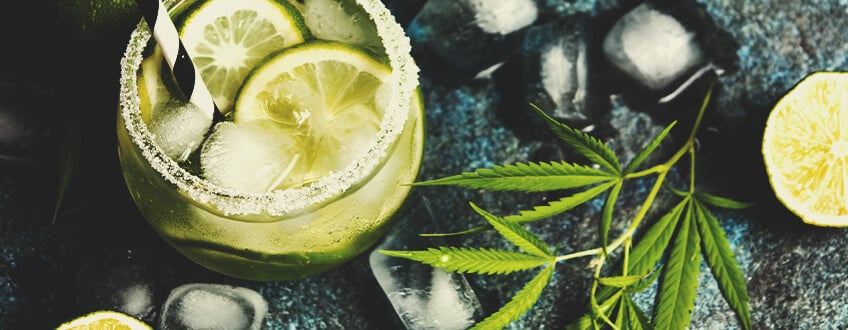
Soups
Nothing’s quite as hearty and wholesome as a big bowl of soup. Whether you like it hot or cold, smooth or chunky, meaty or vegetarian, there are countless different soup recipes you can enhance with the power of CBD.
Cookies and Brownies
Can you think of a more classic way of combining cannabis and food than packing it into a delicious batch of brownies or cookies? We definitely can’t. If you’ve got a sweet tooth, you’ll be glad to know you can infuse virtually any baked good with CBD and cannabis.
Sauces and Dips
Another one of our favourite edible options is to infuse CBD into sauces and dips (both hot and cold). Many sauces and dip recipes call for generous amounts of fat, meaning they’re super easy to infuse with your canna-oil or butter. One of our all-time favourites is a delicious strawberry CBD sauce that goes great with a variety of desserts, and even as an accompaniment to certain savoury dishes.
How To Cook With CBD
Now it's time to dig into the details of how to effectively cook with CBD oil and flower.
Dosing CBD for Cooking
Dosing CBD in your recipes can be difficult, which is why we suggest simplifying it as much as possible. The best way to do so is to calculate how many servings of food you’re preparing and then infuse your standard dose into each serving.
If, for example, you’re making 4 servings of soup, and you typically take 10 drops of CBD oil per day, use a total of 40 drops of CBD in your recipe. If you’ve never taken CBD before, we suggest you try a medium-strength CBD oil for at least a week to familiarise yourself with the compound and how it affects your body.
Then, once you’ve found a dose that works for you, take that same dose and use it in your cooking. If you feel like that dose isn’t working, increase it gradually until you get the effects you’re after. If you’re cooking with dried CBD flower instead of oil, on the other hand, follow this guide to properly dose your CBD edibles.
 CBD Dosage Calculator
CBD Dosage Calculator
 CBD Dosage Calculator
CBD Dosage Calculator
Cooking With CBD Oil
Cooking with CBD oil is the best way to start your journey of using CBD in the kitchen. The process is simple:
- Measure your dose.
- Prepare your food as per your recipe.
- Add in your CBD oil when you see fit. However, as detailed above, try to avoid bringing your CBD oil into direct contact with high heat. So if you want to make CBD-infused pasta sauce or a stir fry, for example, you’d be better off adding the CBD oil in at the end.
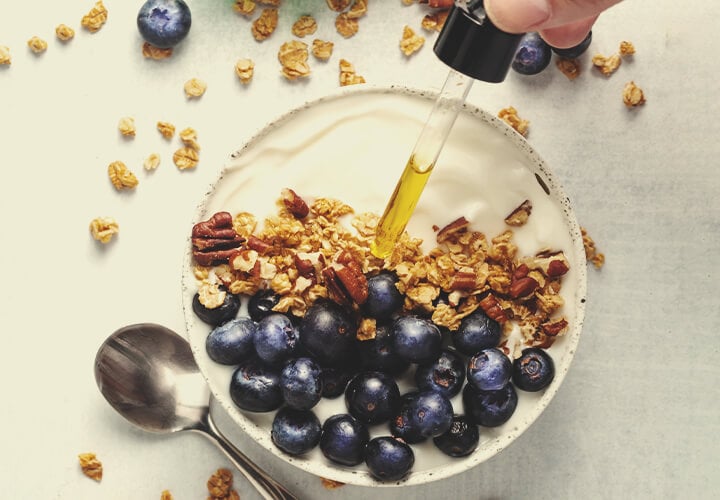
Cooking With CBD flower
Cooking with CBD flower gives you a lot more control over your recipe and is a lot cheaper than adding shop-bought CBD oil every time. It is, however, a lot more hands-on, and can seem a little overwhelming to inexperienced weed cooks.
Here’s how to cook with CBD cannabis flowers:
- Determine the amount of flower you need.
- Grind up your flower and spread it out evenly on a lined baking sheet. Decarboxylate at 110–120°C for 30–40 minutes or until fragrant. Stir regularly to ensure the buds decarb evenly and don’t burn.
- Heat your decarbed flower in the amount of oil or butter required for your recipe. Let the mixture simmer on low heat for 3 hours to extract as many cannabinoids and other active compounds from the buds as possible.
- Strain the oil or butter to remove any plant pieces, let cool, and use as called for in your recipe.
Note: If you regularly cook with CBD, consider making large batches of CBD oil or butter to save time.
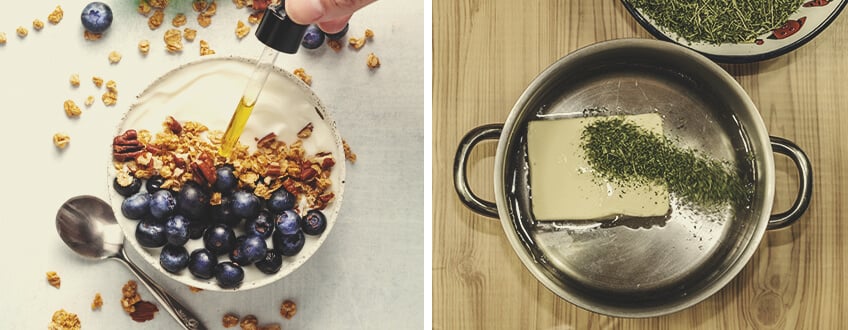
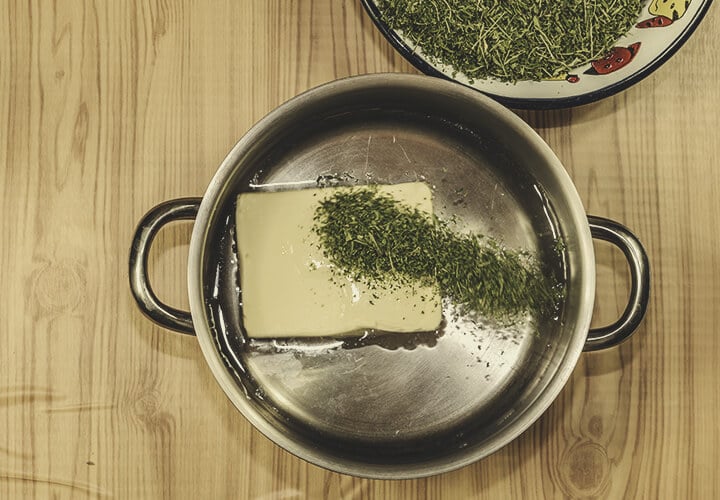
Tips for Cooking With CBD
To ensure your CBD cooking journey starts off without issue, we’ve assembled some must-know tips. Keep these nearby when crafting your own edible infusions, especially if you’re new to the practice.
Grind Your Bud Right
When extracting cannabis flower in oil or butter, it is crucial you grind your buds to the right consistency. In general, we recommend using a coarser grind for longer and slower extractions, and a finer grind for when you need to extract your weed faster. A finer grind helps to reduce the overall surface area of your weed, meaning it will both decarb and extract a little faster than more coarsely ground weed.
Add Fat To Improve Bioavailability
Remember, cannabis compounds are fat-soluble, so don’t make the rookie mistake of throwing a bud or drops of CBD oil into a recipe that doesn’t contain at least some fat. If you’re using CBD flowers, always extract them into cooking oil/fat per the instructions above, and if you’re using CBD oil, make sure to add it into recipes that contain a decent amount of oil or cooking fat. This will help make more of the CBD available to your body.
Avoid Excessive Temperatures
The cannabinoids, terpenes, and flavonoids that give cannabis its unique aromas, flavours, and effects are all very fragile compounds. When exposed to high temperatures above roughly 120°C, these compounds start to break down and evaporate into the air. When making CBD edibles, we obviously want to preserve as many of these compounds as possible, so make sure to avoid exposing your CBD (be it in the form of flower or shop-bought oil) to excessive temperatures.
Timing Is Crucial
Making cannabis oil and butter takes some patience, as the ingredients need to infuse at relatively low temperatures for several hours. Ideally, cook your CBD and oil/fat mixture over low heat for approximately 3 hours for a decent extraction.
Filter With Care
After your raw plant material has been infused into a base of oil or butter, it will need to be strained using a fine filter, such as cheesecloth. This process requires patience as the infused solution slowly but surely drips into the container below. Try to resist the temptation of squeezing the cheesecloth to speed up the process; although your patience may be wearing thin, you will most likely push plant material into the solution if you do so.
Cooking With CBD Is Fun!
In this article, we covered the ins and outs of cooking with CBD. Now that you know the basics, explore recipes (both from our blog and other sources; there are tons out there!) for inspiration and ideas on how to work the magic of CBD into your cooking.



























